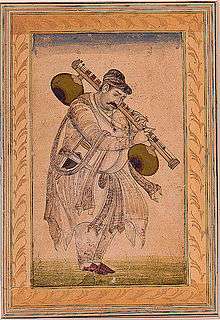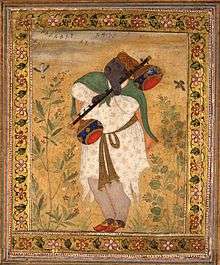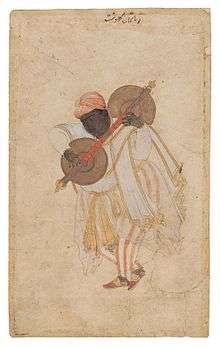Naubat Khan
| Naubat Khan | |
|---|---|
 Portrait of Naubat Khan Kalawant, San Diego Museum of Art, Edwin Binney 3rd Collection | |
| Background information | |
| Birth name | Misri Singh |
| Born | Kishangarh, Rajasthan |
| Genres | Hindustani Classical Music |
| Occupation(s) | Karori, Beenkar, Classical Mughal Era Musician, Darogha of Naqqar Khana |
| Religion | Shia Islam |
| Spouse(s) | Hussaini brahmani |
Naubat Khan (also known as Ali Khan Karori) was a prominent Indian classical music composer, musician and instrumentalist. He was an influential musician of his time. The rudra veena, also called the bin, came into prominence during the time of Tansen's contemporary, and son-in-law, Naubat Khan. In the paintings of the time, it is clearly Naubat Khan and not Tansen who is associated with the instrument.[1] Naubat Khan was the honorary title conferred by Mughal Emperor Jahangir on Ali Khan Karori.[2]
Early life and background
Naubat Khan was the grandson of Maharaja Samokhan Singh of Kishangarh, and the son-in-law of the legendary Tansen.[3] Samokhan Singh, a Jodhpur prince, was himself a great veena player of his time.[4] He was defeated by the forces of the Mughal emperor Akbar, and his grandson Misri Singh (Naubat Khan) was kept under house arrest. Misri Singh later converted to Islam[5] and was named Ali. He was trained under Abdul Rahim Khan-I-Khana, the son of Bairam Khan. Ali was given the title of Khan by Akbar, and the post of Karori, i.e., Finance minister. Ali Khan Karori was later given the prestigious position of the darogha of the Naqqar Khana. Jahangir conferred on Ali Khan Karori the honorary title of Naubat Khan and promoted him to the rank of 500 personnel and 200 horse.[6][7][8]
Marriage with Saraswati
Naubat Khan first married Ahmad Khan Mughal's daughter. After his first wife's death, he married Tansen's daughter, Saraswati. Saraswati accepted Islam and was named Hussaini. They had a son named Lal Khan. Lal Khan was the son-in-law of Tansen's son Bilas Khan.[9] Lal Khan was the chief musician of Emperor Shahjahan.[10] Shahajahan conferred on him the title of Gunsamundra.

Subject of Individual Portrait
Only highly ranked figures of the court enjoyed the privilege of being painted alone or within an assembly by the painters of the court and Naubat Khan is one of the rare musicians – along with the illustrious singer-composer Tansen – to have been the subject of an individual portrait. He was painted by Ustad Mansur during the reign of Mughal Emperor Akbar.[11]

Beenkar dynasty
Naubat Khan was the founder of the Beenkar dynasty of India. His direct descendants commanded respect in musical circles for several centuries. Notable members of this family are
- Lal Khan Gunsamundra (Chief musician of Shahjahan, son-in-law of Tansen's son Bilas Khan)[9]
- Khushal Khan Gunsamundra (Title of Gunsamundra conferred by Shahjahan)
- Bhupat Khan[12]
- Sadarang(Chief musician of Muhammad Shah)
- Feroz Khan Adarang[13]
- Sidhar Khan[14]
- Omrao Khan Beenkar[15]
- Ameer Khan
- Wazir Khan (Master of Hamid Ali Khan of Rampur, Allauddin Khan, Hafiz Ali Khan, Vishnu Narayan Bhatkhande)
- Dabir Khan

See also
References
- ↑ Bonnie C. Wade (January 1998). Imaging Sound: An Ethnomusicological Study of Music, Art, and Culture in Mughal India. University of Chicago Press. p. 119. ISBN 978-0-226-86841-7.
- ↑ Jahangir (Emperor of Hindustan) (1989). The Tūzuk-i-Jahāngīrī, Or, Memoirs of Jahāngīr. Low Price Publications. p. 111. ISBN 978-81-85395-13-5.
- ↑ Stephen Slawek (1987). Sitār Technique in Nibaddh Forms. Motilal Banarsidass Publ. p. 17. ISBN 978-81-208-0200-1.
- ↑ Sunita Dhar (1989). Senia gharana, its contribution to Indian classical music. Reliance Pub. House. p. 13. ISBN 978-81-85047-49-2.
- ↑ Rosemary Crill; Kapil Jariwala (2010). The Indian Portrait, 1560-1860. Mapin Publishing Pvt Ltd. p. 70. ISBN 978-81-89995-37-9.
- ↑ Bonnie C. Wade (January 1998). Imaging Sound: An Ethnomusicological Study of Music, Art, and Culture in Mughal India. University of Chicago Press. p. 120. ISBN 978-0-226-86841-7.
- ↑ "London's Portrait Gallery showcases Mughal art". Rediff. 4 June 2010.
- ↑ Bonnie C. Wade (January 1998). Imaging Sound: An Ethnomusicological Study of Music, Art, and Culture in Mughal India. University of Chicago Press. p. 120. ISBN 978-0-226-86841-7.
- 1 2 Vijaya Moorthy (2001). Romance of the Raga. Abhinav Publications. p. 27. ISBN 978-81-7017-382-3.
- ↑ "romance of raga lal khan gunsamudra - Google Search". google.co.in.
- ↑ "Rudra-Vina, The musicians - The Mughal period". rudravina.com.
- ↑ "Bhupat Khan - Oxford Reference". oxfordreference.com. ISBN 9780195650983.
- ↑ "Who were Sadarang and Adarang?". gktoday.in.
- ↑ "Artist - Siddhar Khan (Tabla), Gharana - Delhi". swarganga.org.
- ↑ Allyn Miner (April 2004). Sitar and Sarod in the 18th and 19th Centuries. Motilal Banarsidass Publ. p. 97. ISBN 978-81-208-1493-6.